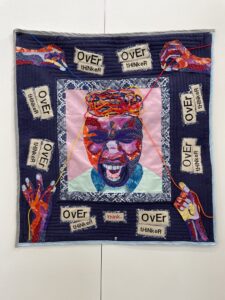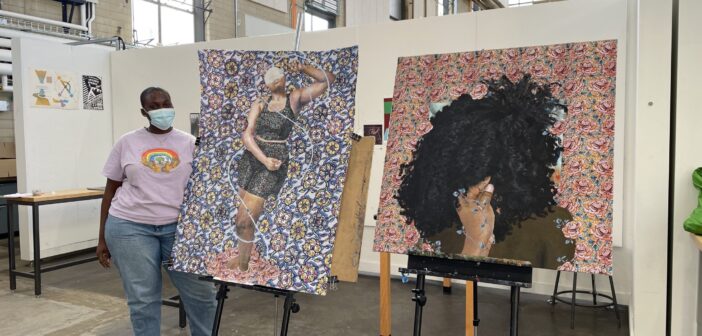When Afiwa Afandalo, ‘24, sat down to brainstorm the concept her work would explore in her Advanced Studio Workshop class, she began by thinking about how the pandemic affected her and her friends. The pandemic was a unanimously emotionally tolling period for them, so she decided to redirect her scope to how Black people heal from trauma.
Advanced Studio Workshop is a high-level course Lehigh offers in the Art, Architecture and Design Department. In the course students are able to choose their concept and mediums of art to explore and to tell different narratives.
Afandalo called her series “Black Joy and Healing.” It currently features two pieces titled, “Hidden Figures: The Matrix of Black Hair,” a piece composed of acrylic and collage on canvas, and “Black Women Genesis: The Birth of a Community,” a piece composed of mixed media collage and color pencil.
“Healing is something that me and my friends, especially one of my closest friends, we talk about a lot as Black women,” Afandalo said. “How can we heal trauma that we’ve experienced and people around us have experienced?”
In her research on how Black people heal, she drew upon her studies as a double major in Africana studies and women, gender and sexualities studies, pulling from books she has read for class, such as Beauty Shop Politics: African American Women’s Activism in the Beauty Industry by Tiffany M. Gill. This book details how Black beauticians used their shops as a site for community gatherings and how the business of hair put a focus on the empowerment of the Black race.
Afandalo said hair continues to be a way women – such as her, her sister and her mom – connect. For her piece “Hidden Figures: The Matrix of Black Hair,” a two-month long project, she painted a photo of her taking down her sister’s braids, a moment she considers sentimental and intimate.
Often drawing from her Togolese culture, Afandalo bordered the piece with a flower motif of an African print. She said she chose to do a collage because of the nature of its layers, which physically and symbolically represent layers in hair.
Afandalo said she wanted the aspects of her art to encourage viewers to come closer and interact with the piece, questioning why different aspects were included.
This concept carries over into the word “matrix” in the title, which Afandalo defines as “something that is there, but we don’t really see or pay attention to.”
For “Black Women Genesis: The Birth of a Community,” Afandalo said she wanted to explore community healing through the creation and well-being of Black women. The piece features a figure who is creating herself with a paintbrush and sharpie in the likeness she wants to be seen.
For the figure, Afandalo used herself. She said in emulating the idea of Black joy, it was important there was joy and healing taking place during the process of creating her art. To do so, she took a video of her dancing to music, since it makes her feel joyful. From here, she took a screengrab of a pose she believed embodied joy, healing and birth, which she later drew in colored pencil for the collage.
Afandalo said although this is not a self-portrait, she does see herself in the piece, as painting and drawing is how she expresses herself. She hopes when other Black women look at the collage, they resonate with the figure.
“When I was creating this piece, I was thinking, when someone looks at it, I want them to see the power of the Black woman,” Afandalo said. “I want them to see my power, I want them to see my friends. I’m a POC (person of color) at a PWI (predominantly white institution) … For me, this is a piece of myself in this community saying that ‘I am here, and I’m a part of this community, even though yes, I am different and the people I interact with daily are different from me. I am here and I’m here to stay.’”
Andrea Jones, ‘22, is another student who took Advanced Studio Workshop. Last semester, she explored quilting as her main medium of art. Her final piece was a quilt – made with yarn and 17 different fabrics – titled “OvEr tHiNkeR.”

Andrea Jones’, ’22, quilt titled “OvEr tHiNkeR.” Jones created the piece for Advanced Studio Workshop. (Courtesy of Deirdre Murphy)
Jones said the piece is inspired by how the fall 2021 semester, when she was taking some of the hardest classes of her college career, contributed to her mental health and personal growth.
“I was struggling with prioritizing time because I realized how much time that I spent analyzing, whether it be equations, or homework or anything instead of being productive,” Jones said. “That took a lot of time, and then it also affects your mental health.”
To create the piece, Jones said she took a photo of herself screaming, which she printed out on a large piece of paper, cut out with an exacto knife and constructed onto the center of her quilt using different colored fabrics. Atop her head, she weaved yarn, each color being pulled in a different direction to symbolize the many things in her life that were causing her to overthink including her classes, family and the world.
Jones said in the nature of trying to curb her overthinking habits, she improvised the colors she used, trusting her gut to choose ones that felt right.
All around the figure she placed the word “overthinker” with random capitalization.
“Overthinker is both uppercase and lowercase letters because there was a trend – I think it was a Spongebob meme – when you over and under capitalize things, it’s kind of a mocking tone,” Jones said. “It was just a way of mocking myself saying that I overthink too much.”
Jones said the project took her about a month to do and came after experimenting with quilting as a medium for drawing and painting with two smaller pieces she completed for the class.
Jones drew inspiration from the women of Gee’s Bend, a small remote Black community in Alabama, who made masterful quilts inspired by African textiles.
She said although she’s been sewing since she was 12, using it as a medium was out of her wheelhouse.
“I’ve always known how to sew, just using it to make art was just completely different out of my zone,” Jones said. “I enjoyed every second of it. Once I learned how to do it once, I knew that it was possible for me to do.”
Jones said her classes in art, architecture and design have been a great way for her to exercise different parts of her brain to balance out the courses in her major, mechanical engineering.
She said this project in particular made her more confident in her abilities as a student.
Although Jones said she knows finding a balance between thinking productively and overthinking can be difficult, she advises others who struggle with overthinking to give themselves more credit and have more confidence in themselves and their work.
“Trust in yourself,” Jones said. “There’s so many different cultures here and everybody thinks in different ways and there’s so many different perspectives. As long as you trust yourself, you can navigate your way through anything.”
Deirdre Murphy, visiting assistant professor of painting and printmaking, said she was inspired by the two students’ work.
Murphy said she feels Jones and Afandalo were able to find their voices as artists, combining their narratives as Lehigh students with history, heritage and personal experience.
“They have that kernel or that spark that is what it takes to be an artist,” Murphy said. “They are true to their voice. They’re not afraid of digging deep into the content of their stories, and then they’re also really brave about experimenting with this new media.”
Coinciding with LUAG’s “Young, Gifted and Black” exhibition, Murphy said she wanted to highlight the young, gifted and Black art students at Lehigh. She invites the community to view her students’ work at Lehigh’s Mountaintop campus.
“I hope the Lehigh community kind of stops and says, ‘Oh, I didn’t know that was happening up there,’” Murphy said. “To just have that moment of celebration and pause for them.”






Comment policy
Comments posted to The Brown and White website are reviewed by a moderator before being approved. Incendiary speech or harassing language, including comments targeted at individuals, may be deemed unacceptable and not published. Spam and other soliciting will also be declined.
The Brown and White also reserves the right to not publish entirely anonymous comments.